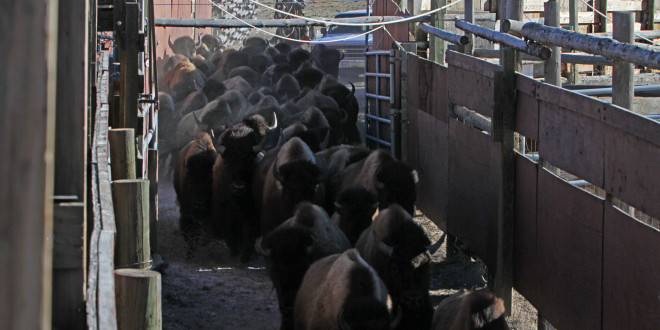Annual operations at the Stephens Creek Bison Capture Facility are gearing up—but some officials are saying a change is necessary.
Every year since 2000, when the Interagency Bison Management Plan went into effect, bison have been corralled into the trap—located just shy of Yellowstone National Park’s northern boundary—and shipped off to slaughter to assuage worries that the animals would venture into Montana and possibly infect cattle with brucellosis.
Of course, there have been no documented cases of brucellosis transmission between bison and cattle. Further, when it comes to transmission risk, elk are far more likely to transfer brucellosis to cattle. Bison, however, are managed far more strictly. Indeed, before Montana Governor Steve Bullock put forth a plan (approved by IBMP partner agencies) to let bison roam year-round in parts of the state adjoining Yellowstone, they were often hazed back into the Park.
These changes (coupled with the National Park Service’s general reluctance in recent years to carry out bison operations) strongly signal a possible shift in Yellowstone bison management. Indeed, according to KBZK, some Yellowstone officials are already calling for changes to IBMP protocol and operations at Stephens Creek. YNP Public Affairs Specialist Jody Lyle, speaking to KBZK, spoke affirmatively on the subject: “We want to find a way to reduce the need for operations here at Stephens Creek. That is going to take a change in the bison management plan that we currently have.”
KBZK.com | Continuous News | Bozeman, Montana
We previously reported that IBMP reps had called for up to 1,300 bison to be culled from Yellowstone’s herd via slaughter and tribal hunting—an estimate biologists say would curb growth. IBMP parameters call for no more than 3,000 bison in Yellowstone National Park; currently, there are an estimated 5,500. From KBZK:
Even though operations at Stephens Creek have not yet begun there are still bison on the property. They are 40 bison held over from last season that have, so far, tested brucellosis free. The plan is to send them to complete quarantine which can take two and a half years at Fort Peck. However, the future of the animals is still up in the air. “There have been some hiccups along the way,” said Lyle.
They’re still waiting for approval of the quarantine plan from the Park Service, which could come any day. But there are also laws that restrict shipping the animals until they are deemed completely brucellosis-free unless they are being shipped to slaughter.
Park Biologist Rick Wallen has been a part of bison operations at Stephens Creek for the past 15 years. His take on it?
“I guess I think we should manage bison like elk.”
In fact, there is not one documented case of brucellosis transmission from bison to elk. There are however cases of elk to bison transmission.
“For the long term, the public debate and conversation needs to be about how we can manage wild bison, can we learn to live with bison on lands outside the national park? Otherwise, it’s just a reserve,” said Wallen.
“More tolerance for wild bison across the landscape is honestly what we believe this wild migratory species deserves,” said Lyle.
It is not known when operations will commence at Stephens Creek. Operations last year started February 15. According to KBZK, Stephens Creek could open as early as January 1, 2017, pending finalization of the IBMP’s winter plan.
 Yellowstone Insider Your Complete Guide to America's First National Park
Yellowstone Insider Your Complete Guide to America's First National Park





